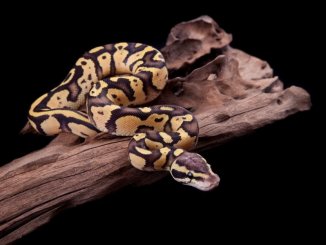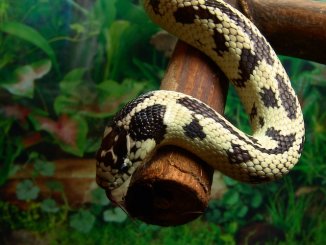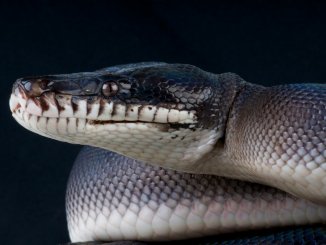The elephant trunk snake (Acrochordus javanicus) is a non-venomous aquatic species native to Asia and Australia. The snake is primarily found in coastal areas. Elephant trunk snakes grow up to eight feet and are renowned for their baggy skin and elephant trunk-like appearance.
Elephant trunk snakes are difficult to care for. They are prone to stress and can’t be handled. It’s a challenge to acclimate trunk snakes as most are wild-caught. Experienced snake keepers will find the difficulty involved rewarding.
Elephant Trunk Snake Overview
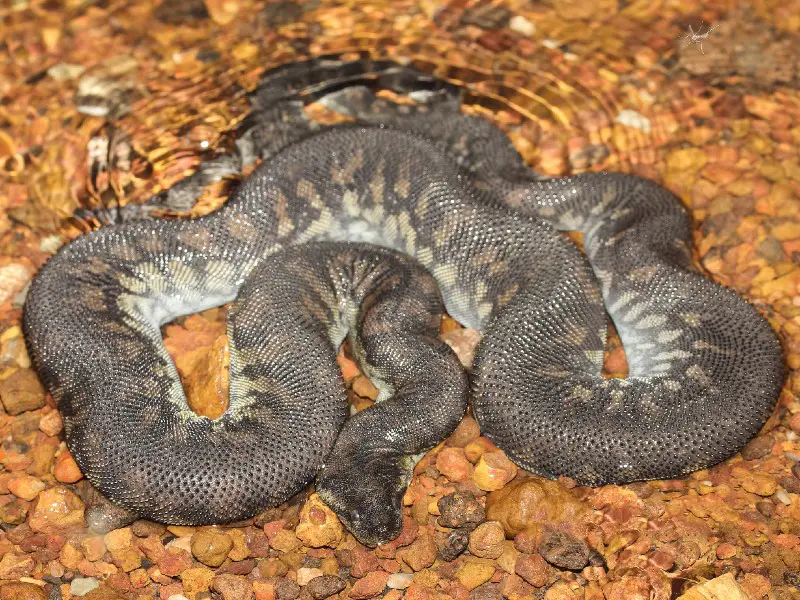
| Category | Rating |
| Common Name(s): | Elephant trunk snake, Javan file snake |
| Scientific Name: | Acrochordus javanicus |
| Natural Habitat: | Coastal areas, brackish, warm freshwater, blackwater |
| Adult Size: | Up to 8 ft |
| Average Lifespan: | 5 years |
| Diet: | Carnivore |
| Housing: | Aquarium, hiding spots, foliage, sandy substrate |
| Experience Level: | Advanced |
Origin
The elephant trunk snake (Acrochordus javanicus) is native to Asia and Australia. This aquatic snake lives in coastal areas and thrives in warm, brackish water.
Elephant trunk snakes commonly occupy blackwater environments and do best in shallow water, where they can more easily find food and shelter. These snakes rarely venture into deep water and can stay submerged for 40 minutes.
Elephant trunk snakes are targeted by hunters in the wild. They are sought after due to their skin and meat. Habitat loss has caused the snake’s population to decline. However, wild elephant trunk snakes are still prevalent. The International Union for Conservation of Nature (IUCN) doesn’t consider these snakes endangered.
Appearance and Behavior
Elephant trunk snakes have a tan hue with a light yellow ventral (belly). The skin of an elephant trunk snake is loose, baggy, and wrinkly. The scales are rough and small. Each scale has a triangular ridge.
Elephant trunk snakes have a muscular build and short tail. They have a broad, snouted head that’s the same width as their body. The eyes and nostrils are positioned on top of the snake’s head. The elephant trunk snake’s common name derives from its elephant trunk-like body shape.
Elephant trunk snakes are sexually dimorphic. Female elephant trunk snakes are longer and larger than males. Males are noticeably slimmer and less well-built.
Virtually all elephant trunk snakes are wild-caught, and these snakes often have white spot fungus on their skin. The fungus will dissipate after shedding if water parameters are appropriate and the snake isn’t stressed. Elephant trunk snakes are shed once every few months. The snakes shed less frequently as they become acclimated to their environment.
Size and Lifespan
Male elephant trunk snakes will grow up to five feet long. Female trunk snakes are often twice the size of males and can grow up to eight feet. These snakes have an average lifespan of four years in the wild and can live up to five years in captivity. Elephant trunk snakes weigh between six and 22 pounds on average.
Temperament
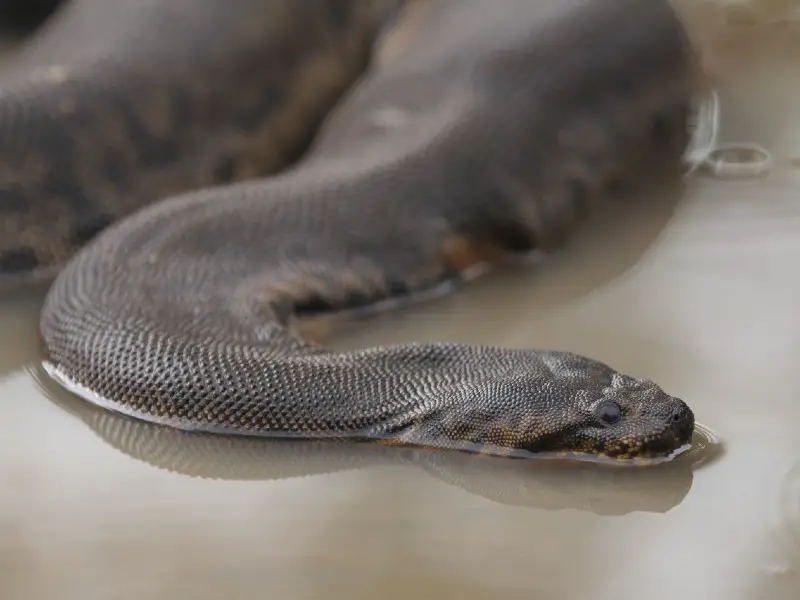
Elephant trunk snakes are shy and are rarely aggressive toward humans. These snakes are prone to stress. Keep noise and movement to a minimum and avoid interacting with elephant trunk snakes. House elephant trunk snakes separately. This will allow each snake to feel more secure and comfortable when feeding.
An elephant trunk snake’s baggy skin allows it to trap prey and move through the water quickly. These snakes are nocturnal. Elephant trunk snakes are ambush hunters and are known to forage. An elephant trunk snake can stay underwater for 40 minutes. It will surface and push its nostrils into the air for 15 to 20 seconds when it needs to breathe.
Avoid handling these snakes. Handling can be detrimental to the elephant trunk snake’s wellbeing and health due to the high stress involved. Elephant trunk snakes will bite if aggravated. Bites can cause serious injury, as the snake’s teeth can break off and get stuck in human flesh.
Housing Elephant Trunk Snakes
Elephant trunk snakes can be found in coastal areas in the wild. These snakes thrive in brackish blackwater with dense vegetation and hiding areas. Housing should mimic the snake’s natural habitat.
Elephant trunk snakes require an aquarium. They are an aquatic species and can’t survive out of water for long periods. The aquarium should have hiding spots, foliage, and leaf litter. The tank needs a secure lid because elephant trunk snakes will try to escape.
Enclosure size
Adult elephant trunk snakes require a 150-gallon aquarium or larger. This size provides the snake ample space to swim around freely and stretch out. House young elephant trunk snakes (up to 20 inches) in a 15 to 30-gallon tank. The water should fill up 50% of the tank.
Lighting
Too much light exposure can cause these snakes to become lethargic or stressed. Elephant trunk snakes are nocturnal and spend most of the day hiding. These snakes require a low-level UV lamp that mimics a natural day-night cycle to help the snakes maintain their circadian rhythm. 12 hours of light per day is ideal. Indirect natural sunlight can work in the right season and location.
Temperature and Water Quality
A temperature of between 84 to 86°F is best for elephant trunk snakes. Use a heater to maintain a regular temperature. Fluctuating temperatures can cause sickness and stress in these snakes. Check the water temperature daily to make sure it stays at the appropriate temperature.
Snake keepers should set up a thermogradient, with a hotter basking area in the tank. 88 to 90 degrees Fahrenheit is ideal for basking.
Elephant trunk snakes thrive in brackish water with a pH balance of 5 to 7.0. Use dried leaf litter to create a blackwater environment. These leaves will release tannins that stain the water and make it acidic. Replace the leaf litter every two weeks.
Ensure the filtration can handle the bioload (waste) but doesn’t generate strong currents. Elephant trunk snakes do best in shallow, slow-moving water. Decorations can help disperse the flow. Avoid internal filters with heavy vibrations. Vibrations can stress the snake and hinder its hunting process.
Substrate and Decoration
Elephant trunk snakes are reclusive and require hiding areas to feel safe and secure. Set up various hides throughout the aquarium. Create hides with logs, driftwood, ceramic pots, caves, and foliage.
Ensure decorations are heavy, tied, or have a weighted base. Elephant trunk snakes are strong and can easily displace lightweight decorations. Mopani wood works well. This wood is heavy, doesn’t float, and releases tannins into the water.
Set up a basking area in the hotter zone using cork bark. This bark will float, providing the snake a platform where it can bask. Cork bark will leach tannins into the water and provide cover. Floating hornwort works well for top coverage too.
Elephant trunk snakes will uproot live plants. Plants must be secured or tied. A substrate is not necessary. A soft, sand substrate will best replicate the elephant trunk snake’s natural habitat, but it can be challenging to clean.
The aquarium must have a secure screen top. Elephant trunk snakes are agile and renowned escape artists.
Cleaning
Perform a partial water change (15% to 25%) weekly to maintain cleanliness. Replace leaf litter, vacuum the substrate, and clean out the canister filter every few weeks. Remove dirty decorations and rinse them over with a disinfectant solution if necessary. Scrub out trapped dirt or debris with a soft-bristled toothbrush.
Wash your hands and arms before starting the cleaning process. Snake keepers should avoid disturbing the elephant trunk snake during cleaning or water changes. Wait until the snake has retreated to a hiding spot before cleaning.
Elephant Trunk Snake Care
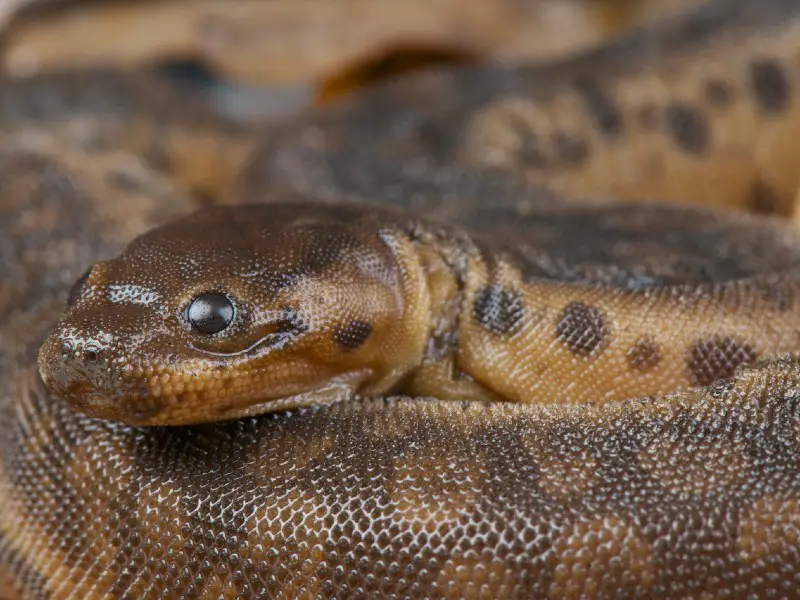
Elephant trunk snakes are difficult to care for. These snakes are prone to stress and health issues, especially white spot fungus. Most elephant trunk snakes in the trade are wild-caught and struggle to acclimate to life in captivity.
Elephant trunk snakes will thrive in a blackwater environment with lots of hiding spots and top coverage. The diet of an elephant trunk snake consists of live fish and amphibians. These snakes shouldn’t be handled. Handling can cause stress or injury.
Food
Elephant trunk snakes are carnivores that eat amphibians and fish in the wild. Feeding these snakes can be costly. Elephant trunk snakes have big appetites and will need to be predominantly fed live fish. Occasionally feed your snake live amphibians such as frogs.
Tilapia is a good food option for elephant trunk snakes. These fish are highly nutritious, affordable, and can be found in most local fish stores. Other foods include guppies, mollies, large bullfrog tadpoles, and convict cichlids. Rosy red minnows are suitable for elephant trunk snakes and are widely available, but they aren’t as nutritious as other fish. Juvenile elephant trunk snakes should be fed fry.
Ensure there is a consistent supply of live feeder fish. Add 10 to 12 fish initially. Top up the tank once there are less than four fish left. Young elephant trunk snakes eat one to two fish per week, while adult fish can eat up to four fish per week. Feeder fish must be the appropriate size for the snake. These fish should be smaller than the elephant trunk snake’s body width. Elephant trunk snakes don’t bulge up after a meal due to their loose skin.
Elephant trunk snakes are nocturnal hunters. These snakes capture their prey through an ambush, wrapping their bodies around the prey to trap it. These snakes aren’t comfortable eating around humans and can be reluctant to eat if they feel shy or stressed. Leave immediately after putting the feeder fish into the tank.
Common Health Issues
Elephant trunk snakes are prone to several health issues. Many snakes don’t survive in captivity. The most common health issue for elephant trunk snakes is white spot fungus, which causes little white spots to develop on the snake’s skin.
Not all commercial fungus treatments will effectively target this type of fungus. Keeping water conditions stable and appropriate is the most reliable long-term treatment. Elephant trunk snakes should not be exposed to stressful situations because stress can also cause white spot fungus.
The white spot fungus will disappear once the elephant trunk snake sheds. Suitable care and treatment is essential to prevent the white spots from returning.
Breeding
Captive breeding of elephant trunk snakes is almost nonexistent in the US. Wild-caught gravid females are used for any breeding that does happen.
Elephant trunk snakes are ovoviviparous. Eggs develop and hatch inside the snake, and the offspring are then born live. Incubation lasts half a year on average. Females produce six to 17 offspring.
Choosing and Buying an Elephant Trunk Snake
Elephant trunk snakes cost between $80 and $150 but are difficult to find. These snakes can sometimes be found in specialty reptile stores. Almost all elephant trunk snakes are imported and are exposed to stress and poor water conditions.
A sick elephant trunk snake will appear lethargic, lack an appetite, and have white spot fungus on its skin. These snakes are only suitable for experienced snake keepers due to their aquatic nature and demanding care requirements.

